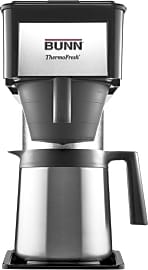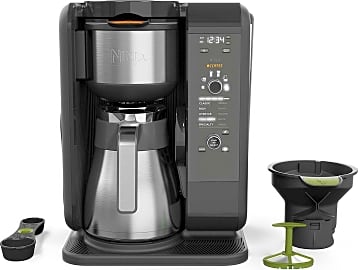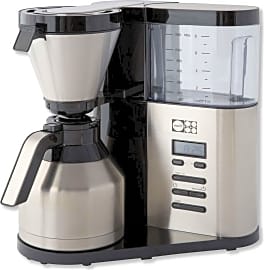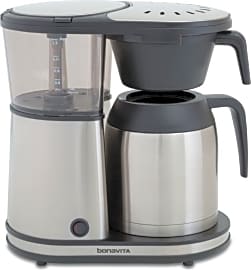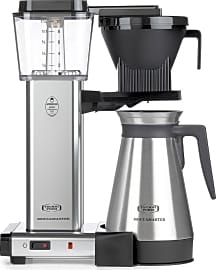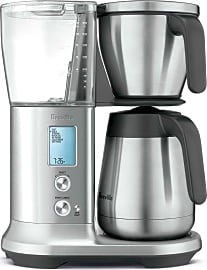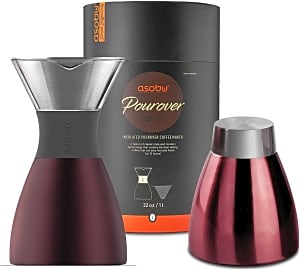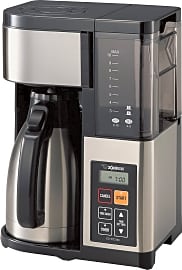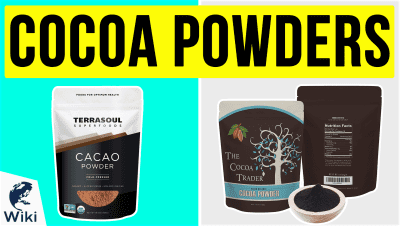The 10 Best Thermal Coffee Makers

This wiki has been updated 30 times since it was first published in July of 2018. If your day doesn't start until that first cup of joe, then you know just how important the right brewing system can be to the flavor and cleanup process of a good pot. Since decent ground beans deserve better than to turn acrid and muddy on a scorching hotplate, we've selected some of the finest and most cost-effective coffee makers that drip into insulated, thermal carafes. When users buy our independently chosen editorial choices, we may earn commissions to help fund the Wiki.
Editor's Notes
November 23, 2020:
It can be tough to find an automated coffee maker that can extract the same range of flavor as a properly executed pour-over, but the Bonavita BV1901TS Connoisseur comes close. If you want a push-button machine that provides a truly delicious cup of joe, then this machine is worthy of strong consideration. It would be ranked near the top of the list if not for some unfortunate design choices that limit its convenience, most notably the inability to program it for the next morning's brew. You also have to wait until the batch is completed to put the lid on the carafe, meaning some heat will escape unless you're standing right next to it when it's finished.
If you're a pour-over purist, then we recommend the Asobu PO300, which features the three-piece hourglass setup familiar to coffee aficionados, but adds copper-lined double-wall insulation. The spout is made of heat-resistant borosilicate glass, and holds a fine-pore steel filter to keep grounds from trickling through. Many users will find the minimalist modern design to be an added plus.
We had to remove a few items from the list based on persistent reports of quality issues. The Cuisinart CHW-14 offers a hot water spout for making beverages like tea and cocoa, but a concerning number of users said that they could detect nasty flavors of plastic or mold in the water it produced. We also got rid of the Hamilton Beach FlexBrew, which seems prone to considerable amounts of leakage. In place of the latter we added the Cuisinart SS-20. Like the FlexBrew, the SS-20 has a single serve option that can be used with pods or grounds, but it accommodates a wider range of mug sizes and seems to be more sturdily built.
If you want to keep your java hot but don't want to replace your coffee maker, check out our list of the best thermal carafes. And if control over your drink's flavor is important to you, then you could always invest in your own roaster.
June 20, 2019:
Designed for convenience, the Oxo On uses a microprocessor for precise time and temperature control to make coffee that will rival the flavor of a labor-intensive handcrafted cup, but with very little effort required. The entire process is controlled by a single dial, and the backlit LED screen shows the brewing status and freshness indicator. If you want great-tasting coffee as quickly as possible, the Bunn Velocity is a good choice. Its preheating tank keeps water hot and ready, so it can make 10 cups in just 3 minutes, and a vacation switch keeps it from boiling dry when you're out of town.
Great for those who like variety, the Ninja Auto-iQ can make both single cups and full carafes, and it has a wide array of settings for hot and iced drinks of different strengths. Plus, it can also brew bagged and loose-leaf tea, and it even has a foldaway milk frother for making lattes and cappuccinos.
If you use high-end specialty beans and want to get the most out of them, there are several machines with blooming cycles designed to replicate the complex flavor produced by the pour-over method, including the Oxo On. The Motif Elements has a specially-designed sprayer that's made for even saturation, and its elbow-shaped design tucks neatly into a corner to save space. It also has a smart decalcification sensor that monitors its performance to let you know when it's time for a cleaning. The Breville Precision allows you to customize everything from the temperature and water flow rate to the length of the bloom cycle, so you can tailor the settings to suit different types of coffee. If you're willing to spend a bit more, the Technivorm Moccamaster is a high-end, handcrafted machine with a durable metal body and a copper heating element that heats quickly and turns off automatically when the reservoir is empty. It may be pricey, but it's built to last and comes with a five-year manufacturer's warranty, so you won't need to replace it for a while.
Why Go Thermal?
Once the process is complete, you pour yourself a steaming mug and enjoy it thoroughly.
You don’t have to be a java expert to know that stale, bitter coffee is not your friend. If you’ve ever owned a run-of-the-mill drip machine with a glass pot, then you’re probably familiar with the following scenario: You turn your trusty machine on and set it to brew a full pot of your favorite joe. Once the process is complete, you pour yourself a steaming mug and enjoy it thoroughly. You return for your second cup after a few minutes, fully expecting the same flavorful experience. Your heart sinks when you take the first sip. It suddenly tastes bitter. How did that happen?
When you use a glass pot, it’s typically outfitted with a flip-up top and measurement marks. This is so you can pour the right amount of water in to dispense into the machine’s tank. A wide, unsealed lid also makes it easy to rinse it out when all is said and done. However, this convenience comes at a cost. Without any barrier, oxygen starts to creep into your brew and combine with its oils. At the same time, volatile acids escape and the liquid stews. The result? It only takes about 20 minutes for your java to lose its freshness.
Glass pots require a hot plate to stay warm, whereas a thermal carafe uses insulation. Thanks to a double-walled, vacuum-sealed construction and tight-fitting lid, the latter is able to keep liquids fresh and hot for hours on end. This means you’ll have delicious, piping hot coffee on hand for much longer, and you won't even need to use any electricity.
How many times have you rinsed a glass pot in the sink and accidentally dinged it against another dish, shattering it in the process? Since thermal carafes are usually crafted from hardwearing stainless steel, breaking one will never be an issue. As an added bonus, you can safely touch a thermal carafe anywhere on its body without sustaining any burns.
How To Get The Most Out Of Your Thermal Coffee Maker
If you’re going to the trouble of purchasing a thermal coffee maker to preserve your java’s flavor, the last thing you need is for some other variable to make it taste funky. Dirty machines are the worst offenders, but even the type of water you use and the brewing temperature can have an adverse effect. Here are a few things to keep in mind for an optimal brewing experience.
If you’re going to the trouble of purchasing a thermal coffee maker to preserve your java’s flavor, the last thing you need is for some other variable to make it taste funky.
Keep it clean. After every use, it’s best to rinse your carafe out with hot, soapy water and let it thoroughly air dry. You’ll want to give your machine a good wipe down, as well as remove old grounds in a timely manner. Every few weeks, flush it out with a solution of white vinegar and water. This helps with mineral buildup and balancing pH levels, plus it kills bacteria.
Ensure that you’re using the right water. That means nothing overly filtered or overrun with minerals. Shoot for something that strikes a nice balance between the two, like water from a pitcher with a filter or your refrigerator’s dispenser.
Check that your coffee maker brews at the proper temperature, which is anywhere between 195 and 205 degrees Fahrenheit. Many machines are already programmed to do this, with some higher-end models allowing you to set the temperature yourself.
After that, it's up to you to make sure you're getting quality coffee beans and storing them properly. Fresh, whole beans are usually your best bet. Experts contend that grounds start losing flavor after 30 minutes, so try to grind the amount you need right before you brew. Most drip machines call for a medium to medium-fine consistency for the best results. Follow these simple steps, and you'll be enjoying artisanal-level java at home in no time.
A Centuries-Old Addiction
With a history spanning hundreds of years, it's no wonder that coffee has been hailed as everything from the devil's drink to the beverage of revolution. Believed to have originated in Ethiopia, a handful of legends have sprung up to explain its discovery. Some say it happened when Kaldi, a 9th century goat herder, noticed his flock become visibly excited after eating berries from a tree. Intrigued, he brought a sampling to the local monastery, where he and an abbot tossed them into a fire. They knew they were onto something when the room filled with a tantalizing aroma.
If you were a holy man, it helped you focus on your devotionals day and night.
Then there was Omar, a sheik exiled from present-day Yemen. One day, feeling peckish, he gathered some berries to eat. They were bitter, so he roasted them. That just made them hard, so he submerged them in boiling water. He drank the resultant brown beverage and felt instantly energized. News of his discovery spread, and coffee gained popularity throughout the Arab world.
Regardless of what you believe, the first credible evidence of coffee dates back to the late 15th century, when it was being exported from Ethiopia to Yemen. Thanks to its fragrance and taste, it was in high demand. It was also an extremely practical drink. If you were a holy man, it helped you focus on your devotionals day and night. Soldiers would stay alert for hours on end, while merchants could ply their wares all day without feeling tired.
It wasn't long until coffee houses began popping up, first in the Middle East and Africa, and later in Europe and England. These public cafes were the lifeblood of their communities. People frequented them for musical entertainment, to talk shop, cut deals, and hear the most literate men of the day espouse on various subjects. Before there was a world wide web, folks visited a coffee shop to learn about current events. In times of political crisis, they'd even discuss revolution.
Whether people loved or feared it, coffee has never failed to capture our imaginations. It's now one of the most widely consumed and traded beverages in the world, with devoted enthusiasts across the globe.


